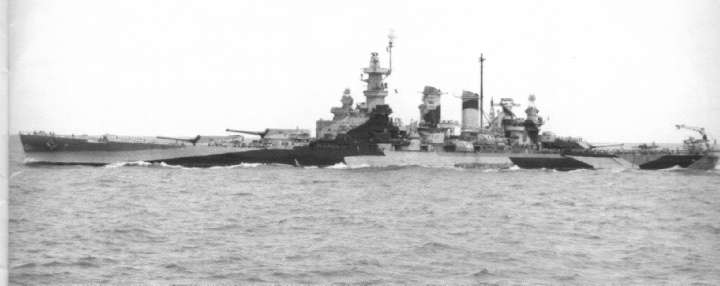

Between the last battleship
class constructed just after World War I, the Marylands, and the
next, the North Carolinas, was a gap of 17 years. These seventeen
years guaranteed that the new battleship design would be vastly different
from the older ships.
The decisive factor in the construction of the North Carolina
class certainly was the Washington Naval Arms Limitation Treaty of 1922,
and the London Naval Treaty of 1936, replacing and adding to the earlier
treaty.
The major problem in these ships' design was Japan. That country had threatened
to abandon the treaties it had signed in 1934 (and would do so, in 1937),
which essentially left the remaining signatories in a problematical situation.
If they continued to adhere to the treaties, they might find themselves
opposed by battleships much more capable than their own. If they didn't
adhere to the treaties, a new arms race might follow, which no signatory
desired.
Thus, a clause was inserted according to which the signatories were allowed
to go over the treaty limitation of 35,000 tons, 14" guns, if a signatory
cancelled or broke the treaty.
The North Carolina-class design started in 1934. Though the problems
one could expect from such strict limitations as those of the Washington
Treaty were encountered and solved, the major issue of the main gun caliber
was not decided until the last minute. 406mm were prefered by President
Franklin D. Roosevelt, among others, but 14" was the treaty standard and
using it would be a sign to the other signatories that the U.S. desired
adherence to the treaty. This problem led to a simple solution: if Japan
adhered to the 14" limit, so would the U.S. -- if not, 16" guns would be
used. Thus the barbettes were constructed in such form that either of two
turrets, a quadruple 14" or a triple 16", could be installed.
As it turned out, Japan did not desire to keep anywhere near the treaty
limits, and in 1937, shortly before the keels for the two ships were laid,
the 16" variant was ordered. It was too late, however, to also change the
armor outfit, which remained set to protect the ship against 356mm shellfire,
contrary to the old rule-of-thumb maxim that a battleship should be armored
against guns of its own caliber.
As the first completed battleship design in 17 years, the North Carolinas
suffered some serious vibration problems, sometimes effectively limiting
their speed to less than their maximum. They did introduce the torpedo
protection system that became the basis of all later battleship designs.
Both battleships saw extensive service during the war. North Carolina
herself was first to go to the Pacific in June, 1942, after the Battle
of Midway, having spent most of her prior career off the Eastern seaboard.
She escorted carriers until torpedoed by a Japanese submarine, returned
to the Solomons after her repairs, and supported the carriers in all major
campaigns of the Pacific War. She remains a floating museum on the Cape
Fear River near Wilmington, North Carolina.
USS Washington served a brief stint with the British Home Fleet
guarding against a breakout of Tirpitz, then was sent to the Pacific
in November of 1942. She fought successfully in the Second Naval Battle
of Guadalcanal, sinking the Imperial Japanese battleship Kirishima
with 16" fire, then followed much the same career as North Carolina,
being scrapped in 1961.
Ships in class:
BB-55 North
Carolina
BB-56 Washington
|
|
Displacements:
Standard: 37.485 tons Full: 44.377 tons Length: 222.17m / 728ft 11" Beam: 33m / 108ft 4" Draft (Full Load): 10.7m / 35ft Height: ???? / ???? Crew (Officers/Men): 99/2035 Endurance: 15.000nm at 15 knots Speed: 28 knots |
|
|
Belt: 12 - 6in /
304 - 152mm, sloped 15°
Deck: 4.1 - 3.6in / 104 - 91mm Barbettes: 16 - 14.7in / 406 - 373mm Gunhouses: 16 - 9.8in / 406 - 24.9mm Conning Tower: 16 - 14.7in / 406 - 373mm |
|
|
(As designed):
Main: 9 x 406mm L/45 in three triple turrets, two superfiring forward, one aft Secondary: 20 x 127mm L/38 in ten twin mounts, five on each side AA: 16 x 28mm L/74 in four quadruple mounts, one each forward, aft, port and starboard 18 x 12.7mm L/90 in single mounts Aviation: 4 planes, two catapults |
| (Washington,
1944):
Main: 9 x 406mm as above Secondary: 20 x 127mm L/38 as above AA: 60 x 40mm in quad and twin mounts 50 x 20mm in single mounts Aviation: 4 planes, two catapults |